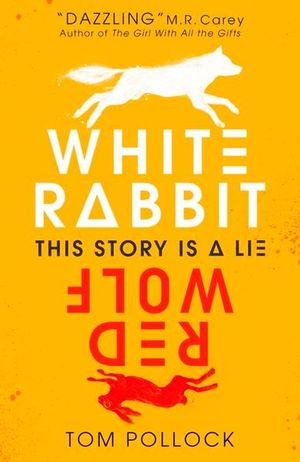Tom Pollock, White Rabbit Red Wolf, Walker Books, July 2018, 410 pp., $16.99, (pbk), ISBN 9781406378177
Brilliant! Tom Pollock, inspired by personal experiences, excels with this story.
Imagine being in such mental anguish, scared you will ruin another person’s day, that the silence of the night and your frenzied thoughts make you crush porcelain with your teeth. The first few pages of Tom Pollock’s latest book had me hooked. The scene, the mood and the narrator were firmly established early in my mind and I was ready for the story to unfold.
In this YA psychological thriller, immerse yourself in the mind of Peter Blankman, a mathematical genius using the predictable patterns of mathematics to try to counteract his extreme anxiety disorder.
When his mother is left for dead at her own award ceremony and his sister goes missing, Peter becomes caught in a web of lies and conspiracies. He doesn’t know who he can trust; even his friends and family are suspect. Pulled into a world where political and family secrets intertwine, Peter feels an overwhelming compulsion to find his mother’s attackers and solve the mystery behind his birth. But his greatest battle will be with the enemy inside himself: the constant personal triggers that threaten to engulf him.
In this complex plot, Tom Pollock uses Peter’s memories, relaying them in a style I call organized chaos. The chapters alternate between past and present until they eventually merge to expose unexpected twists and turns. I found my mind constantly recalling the book’s tagline: This story is a lie; all the way to the last page, I was wondering how reliable each chapter was to Peter’s story.
Mathematics plays a large role in the plot and I stumbled over these references only because my understanding of maths is very basic, but I did not feel that this detracted from the story…. It added emphasis to the brilliance of Peter’s mind. Paired with Peter’s anxiety and panic attacks, the maths made the story richer, adding a unique voice to the telling.
Pollock’s paranoid world has real substance thanks to his skilful development of the characters. For example, Peter’s character was witty and sarcastic and I kept highlighting quotes as examples for this review but there were too many.
This reminds me of a more stimulating version of Mark Haddon’s The Curious Incident of the Dog in the Night-Time and was as funny and poignant as Libba Bray’s Going Bovine. Suitable for older teen readers.
Reviewed by Sharon Smith

